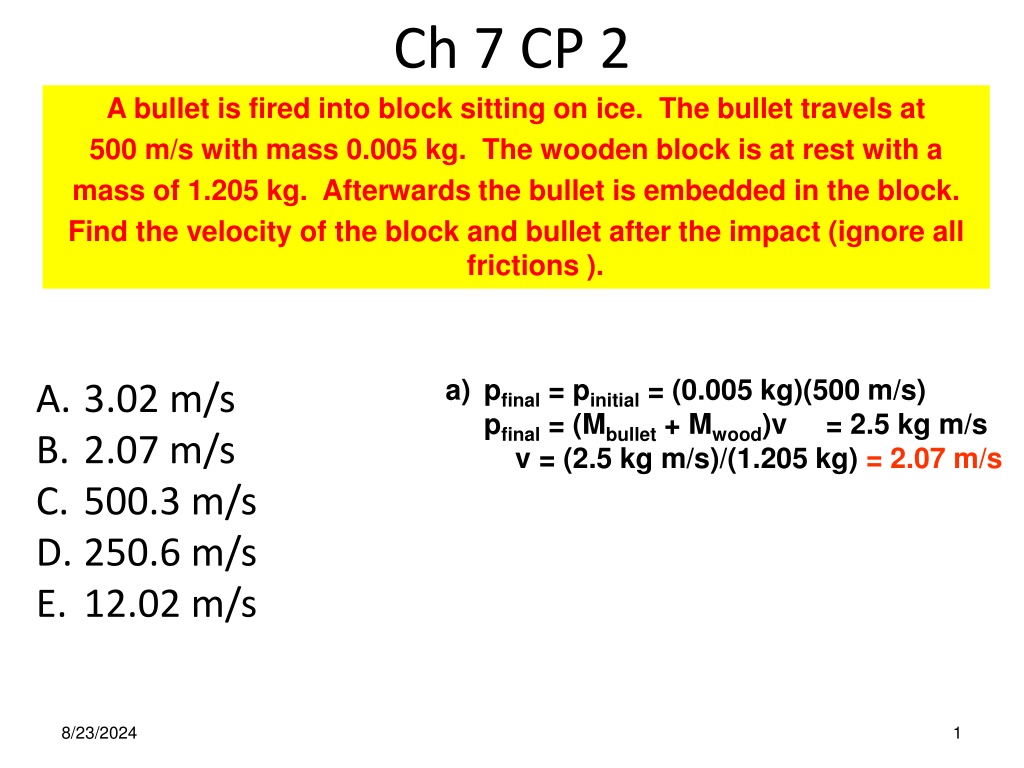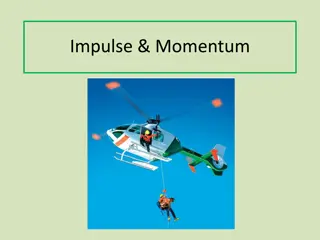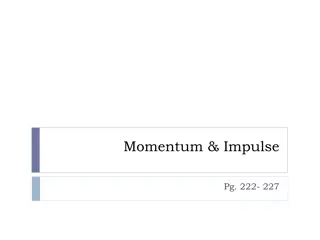Understanding Momentum in Physics
Explore the concept of momentum in physics through scenarios involving collisions and rotational displacement. Learn how momentum is conserved in different situations and its impact on the final direction of motion. Discover the relationship between velocities, masses, and changes in momentum in various physics problems.
Download Presentation

Please find below an Image/Link to download the presentation.
The content on the website is provided AS IS for your information and personal use only. It may not be sold, licensed, or shared on other websites without obtaining consent from the author. Download presentation by click this link. If you encounter any issues during the download, it is possible that the publisher has removed the file from their server.
E N D
Presentation Transcript
Ch 7 CP 2 A bullet is fired into block sitting on ice. The bullet travels at 500 m/s with mass 0.005 kg. The wooden block is at rest with a mass of 1.205 kg. Afterwards the bullet is embedded in the block. Find the velocity of the block and bullet after the impact (ignore all frictions ). a) pfinal = pinitial = (0.005 kg)(500 m/s) pfinal = (Mbullet + Mwood)v = 2.5 kg m/s v = (2.5 kg m/s)/(1.205 kg) = 2.07 m/s A. 3.02 m/s B. 2.07 m/s C. 500.3 m/s D. 250.6 m/s E. 12.02 m/s 8/23/2024 1
Ch 7 CP 2 A bullet is fired into block sitting on ice. The bullet travels at 500 m/s with mass 0.005 kg. The wooden block is at rest with a mass of 1.205 kg. Afterwards the bullet is embedded in the block. Does the change in momentum of the bullet equal that of wood and how much are the changes? A.yes. 2.50 kg m/s B.No. Wood changes 2.50 kg m/s. Bullet changes less than that. c) p for bullet = (0.005 kg)(500 m/s) (0.005 kg)(2.07 m/s) = 2.50 kg m/s Momentum is conserved, so momentum lost by bullet is gained by wood. 8/23/2024 2
Collisions at an Angle The total momentum of the two football players prior to the collision is the vector sum of their individual momentums. The larger initial momentum has a larger effect on the final direction of motion.
Two lumps of clay of equal mass are traveling at right angles with equal speeds as shown, when they collide and stick together. Is it possible that their final velocity vector is in the direction shown? a) b) c) yes no unable to tell from this graph No. The final momentum will be in a direction making a 45o degree angle with respect to each of the initial momentum vectors.
Quiz: Two cars of equal mass Collide at right angles to one another in an intersection. Their direction of motion after the collision is as shown. Which car had the greater velocity before the collision? a) b) c) Car A Car B Their velocities were equal in magnitude. It is impossible to tell from this graph. d) Since the angle with respect to the original direction of A is smaller than 45 , car A must have had a larger momentum and thus was traveling faster.
Rotational displacement is how far the object rotates. Units: fractions of a complete revolution; degrees; radians 1 complete revolution = 360o = 2 radians Analogous to linear displacement: the straight-line distance traveled by an object (including direction of travel) 6
Rotational velocity is how fast the object is turning. Units: revolutions per minute (rpm); degrees per second Analogous to linear velocity 7
Rotational acceleration is the rate of change of rotational velocity. Units: revolutions per second per second (rev/s2); radians per second per second (rad/s2) Analogous to linear acceleration 8
Constant acceleration equations for linear and rotational motion v = v0+ at = 0+ t d = v0t +1 = 0t +1 2 t2 2at2 9
Relationship between linear and rotational velocity On a merry-go-round, a rider near the edge travels a greater distance in 1 revolution than one near the center. The outside rider is therefore traveling with a greater linear speed. ? = 2 ? ? ?=2 ? ? v = r 10
A merry-go-round is accelerated at a constant rate of 0.005 rev/s2, starting from rest. What is its rotational velocity at the end of 1 min? 0.005 radian/s 0.3 radian/s 0.05 radian/s 1.88 radian/s a) b) c) d) = 0.005 rev/s2 0 = 0 t= 60 s = 0 + t = 0 + (0.005 rev/s2)(60 s) = 0.30 rev/s = 0.3*2*3.14 radian/s = 1.88 radian/s 11
How many revolutions does the merry-go-round make in 1 minute? 1.5 rev 3.0 rev 9.0 rev 18.0 rev a) b) c) d) = 0.005 rev/s2 0 = 0 t= 60 s, = 0.30 rev/s = 0t + 1/2 t2 = 0 + 1/2 (0.005 rev/s2)(60 s)2 = 9 rev 12
Torque and Balance What causes the merry-go-round to rotate in the first place? What determines whether an object will rotate? If an unbalanced force causes linear motion, what causes rotational motion? 13
Torque and Balance When is a balance balanced? Consider a thin but rigid beam supported by a fulcrum or pivot point. If equal weights are placed at equal distances from the fulcrum, the beam will not tend to rotate: it will be balanced. 14
To balance a weight twice as large as a smaller weight, the smaller weight must be placed twice as far from the fulcrum as the larger weight. Both the weight and the distance from the fulcrum are important. The product of the force and the distance from the fulcrum is called the torque. 15
The distance from the fulcrum to the point of application of the force must be measured in a direction perpendicular to the line of action of the force. This distance is called the lever arm or moment arm. For a force F and a lever arm l, the resulting torque is: = Fl A longer lever arm produces a greater torque. 16
Quiz: Which of the forces pictured as acting upon the rod will produce a torque about an axis perpendicular to the plane of the diagram at the left end of the rod? F1 F2 Both. Neither. a) b) c) d) F2 will produce a torque about an axis at the left end of the rod. F1 has no lever arm with respect to the given axis. 21
The two forces in the diagram have the same magnitude. Which force will produce the greater torque on the wheel? F1 F2 Both. Neither. a) b) c) d) F1 provides the larger torque. F2 has a smaller component perpendicular to the radius. 22
A 50-N force is applied at the end of a wrench handle that is 24 cm long. The force is applied in a direction perpendicular to the handle as shown. What is the torque applied to the nut by the wrench? 6 N m 12 N m 26 N m 120 N m a) b) c) d) 0.24 m 50 N = 12 N m 23
What would the torque be if the force were applied half way up the handle instead of at the end? 6 N m 12 N m 26 N m 120 N m a) b) c) d) 0.12 m 50 N = 6 N m 24
Whats the lever arm between F and the fulcrum? A. l B. a C. b a b 25
When the applied force is not perpendicular to the crowbar, for example, the lever arm is found by drawing the perpendicular line from the fulcrum to the line of action of the force. We call torques that produce counterclockwise rotation positive, and torques that produce clockwise rotation negative. 26
Two forces are applied to a merry-go-round with a radius of 1.2 m as shown. What is the torque about the axle of the merry-go-round due to the 80-N force? +9.6 N m -36 N m +96 N m -36 N m a) b) c) d) 1.2 m 80 N = +96 N m (counterclockwise) 27
What is the torque about the axle of the merry-go-round due to the 50-N force? +60 N m -60 N m +120 N m -120 N m a) b) c) d) -(1.2 m 50 N) = -60 N m (clockwise) 28
What is the net torque acting on the merry- go-round? +36 N m -36 N m +96 N m -60 N m +126 N m a) b) c) d) e) 96 N m (counterclockwise) - 60 N m (clockwise) = +36 N m (counterclockwise) 29
We want to balance a 3-N weight against a 5-N weight on a beam. The 5-N weight is placed 20 cm to the right of a fulcrum. What is the torque produced by the 5-N weight? a) b) c) d) +1 N m -1 N m +4 N m +4 N m = - Fl F = 5 N l= 20 cm = 0.2 m = - (5 N)(0.2 m) = -1 N m 30
Quiz: How far do we have to place the 3- N weight from the fulcrum to balance the system? a) b) c) d) 2 cm 27 cm 33 cm 53 cm l = / F F = 3 N = +1 N m = (+1 N m) / (3 N) = 0.33 m = 33 cm 31























